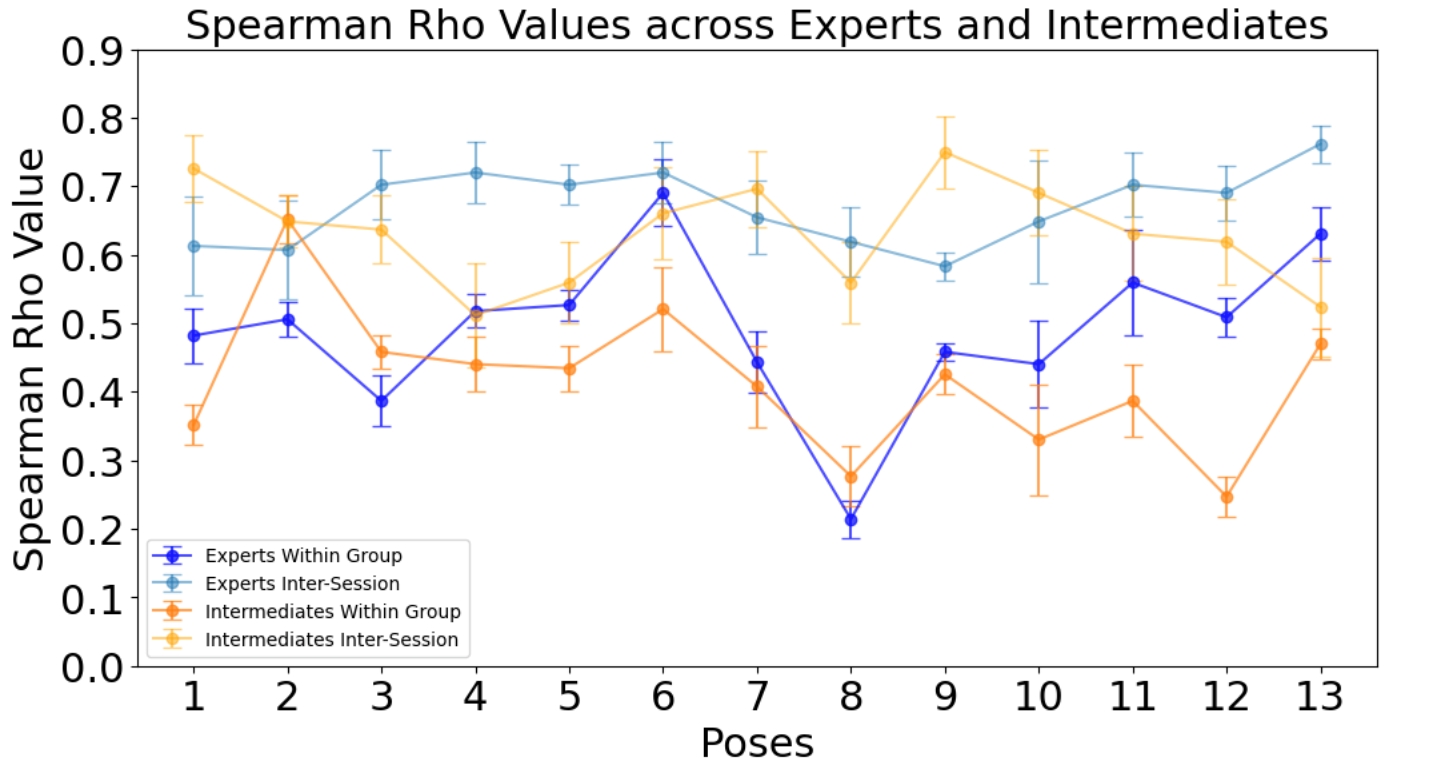In this study, we used surface EMG to record muscle activations during 13 yoga poses performed by 10 intermediate and 10 expert practitioners over two sessions (n=20). We sought to determine whether EMG could reliably measure muscle activation across different skill levels and reflect expertise. We recorded engagement in eight muscles (channels) and analysed activity patterns across trials, comparing consistency within and across sessions and participants using Spearman Correlations. We hypothesised that pose-specific muscle activity “signatures” would be highly consistent within and across individuals, with experts showing greater consistency than intermediates.
Our findings showed that EMG pose signatures as calculated through Spearman correlations and repeated measure ANOVA were consistent within sessions, regardless of expertise, and that poses did have distinct signatures [effect of Pose(F(6.377, 114.782) = 3.859, p < 0.001, η² = 0.145]. When exploring muscle engagement instead of correlation, experts displayed more efficient muscle engagement across specific poses [Pose*Expertise interaction (F(4.725, 70.881) = 3.403, p = .009, η² = .015 and Pose*Channel*Expertise interaction (F(84, 1260) = 2.406, p < .001, η² = .042)]. In weight-bearing poses downward dog and chaturanga, experts engaged the anterior deltoids (t=-3.693, p=.002) and upper trapezius (t=-2.674, p=.015) less than intermediates, who over-relied on these muscles. Additionally, experts demonstrated a consistent pattern of increased activation of stabilising muscles such as longissimus and serratus anterior, tailored to each pose’s demands. This approach demonstrates greater efficiency and expertise by utilising specific stabilising muscles to improve control and effectiveness while minimising unnecessary effort during the poses. Experts showed greater consistency across sessions (Expert M=.644, SE=.019; Intermediate M=.593, SE=.033) and in comparison with their peers than intermediates [Expertise (F(1,16) = 3.677, p = .073, η² = .028)], especially in poses requiring robust stabilisation, aligning with stronger engagement of stabilising muscles, particularly the serratus anterior (Figure 1, Session muscle engagement by pose across channels for experts in white and intermediates in black. (A) Pose 4, experts display higher engagement in channel 5 and 6. (B) Pose 5 and 13 (C) in which experts use channel 5 significantly more than intermediates, and have higher engagement of Channel 6.). Notably, in poses requiring robust stabilisation, experts exhibited more uniformity with their peers than intermediates did with their own repetitions across sessions (See Figure 2, Comparison of expert and intermediate consistent inter-session and intra-group. Experts have the highest consistency for both comparisons.). In contrast, intermediates showed greater consistency in weight-bearing poses, where they also relied more heavily on the anterior deltoids and upper trapezius. This indicates a compensatory use of these accessible muscles rather than adopting more effective stabilising strategies.
These findings demonstrate EMG’s effectiveness in capturing precise muscle engagement, with consistency across sessions and within participants in stabilisation-demanding poses as a key marker of expertise. Future work will explore providing real-time EMG feedback to help practitioners refine their postures and muscle coordination, improving consistency and engagement. These advancements could extend to other physical disciplines and rehabilitation, offering insights into proprioception, injury prevention, and athletic performance while advancing understanding of motor control.


